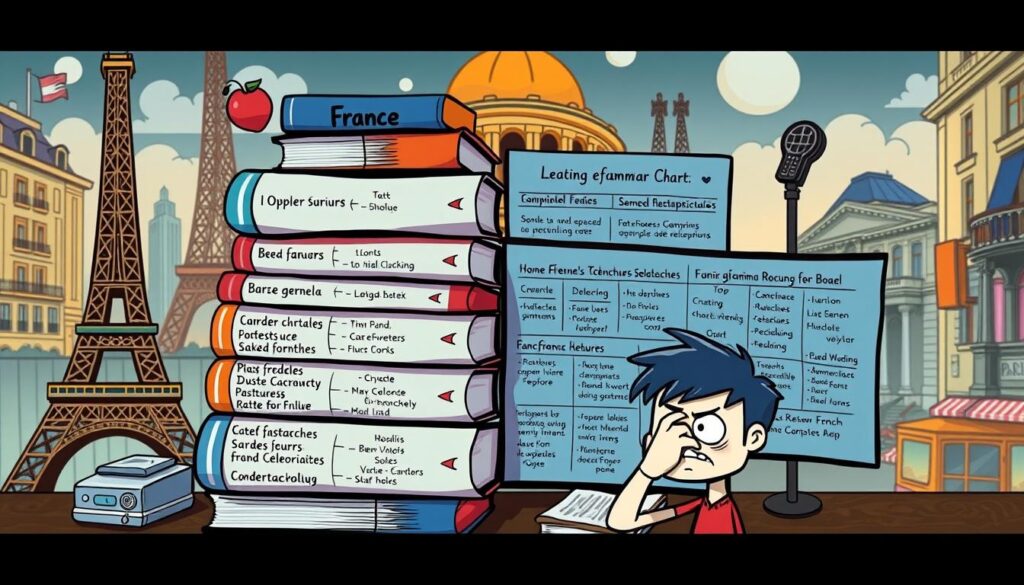Embarking on the journey to master both French and Italian is exciting. These languages have a shared Latin background, making it easier to learn both. They boost your brainpower and open up worlds filled with rich culture. You might wonder, can you learn French and Italian at the same time? The answer is yes, thanks to the benefits of bilingualism.
French and Italian are quite different, with French’s unique sounds and Italian’s clear vowels. You can use their differences to your advantage. Linking similar words between the two helps you learn faster. Though it seems tough, setting clear separate identities for each can avoid confusion.
Learning both languages improves your memory and job prospects in fields like tourism. Wondering, Is French a hard language to learn? Tools helping with French will aid your Italian learning too. Lingopie and Duolingo provide great resources. Make sure to practice both languages regularly, dedicating time each day to them.
So, it’s a myth that learning French and Italian together is too hard. By having clear goals and engaging with both languages through media, you’ll reap the benefits. This approach to bilingualism enhances your cognitive abilities in many ways.
Embracing Bilingualism Advantages Through French and Italian
Starting to learn multiple languages, like French and Italian, opens up many benefits. The benefits include better thinking skills and deeper understanding of cultures. Learning French and Italian together makes you more efficient in learning languages. It also helps you in today’s global world.
Becoming bilingual is about more than talking to more people. For example, people who learn multiple languages have better memory and attention. Also, knowing both French and Italian at the same time makes you more flexible in thinking. This lets you solve problems better and adjust to new cultures easier.
| Cognitive Benefit | Impact of Bilingualism |
|---|---|
| Enhanced Memory | Bilingual people often have a better memory because they practice using different languages often. |
| Cognitive Flexibility | This means being able to switch your focus more easily, which improves how you think and pay attention. |
| Cross-Cultural Communication | Being bilingual makes it easier to understand and interact with people from different cultures, helping you grow personally and professionally. |
| Competitive Edge in Career | Knowing multiple languages gives you an edge in global fields, like business, tourism, and diplomacy. |
| Academic and Educational Opportunities | This increases your chances for studying abroad and taking professional courses by letting you connect with more cultures directly. |
This table shows real benefits for your mind and career from learning languages. Learning multiple languages, like French and Italian together, boosts your growth. It offers new cultural experiences and valuable skills for today’s world.
The journey of learning French and Italian together shapes you into a well-rounded person. It also greatly improves your brain’s ability to engage with the world.
Can You Learn French and Italian at the Same Time?
Learning French and Italian at the same time is a unique adventure. It offers both challenges and amazing opportunities. By adopting methods to learn French and Italian into your routine, it might seem hard but is very rewarding. This journey brings great cognitive benefits of learning two languages.
Understanding the Cognitive Benefits of Dual Language Learning
Learning two languages simultaneously is like a brain gym. It improves your mental agility to switch between languages. This includes different speech patterns, sounds, and words. It makes your brain more flexible and boosts your problem-solving skills.
Handling both French and Italian languages makes your brain form new connections. This boosts your memory and multitasking skills.
Time Management and Effective Study Routines
It’s crucial to manage your study time well with French and Italian. Setting up effective language study routines is key to learning without mixing them up. You could study French in the morning and Italian at night, or switch between the languages on different days. This keeps your learning organized.
Keeping the languages separate helps focus on each one better. It reduces confusion and improves memory of each language.
Strategies to Avoid Confusion and Enhance Retention
To keep French and Italian straight, use special strategies. Try using flashcards that mix both languages. This helps you compare and remember better. Also, dive into each culture by using media like watching Italian movies or listening to French podcasts on alternate days. It deepens your understanding of each language’s nuances.
In short, with hard work and the right strategies, you can learn French and Italian simultaneously. It’s a challenge that makes you not only skilled in languages but also broadens your cultural horizon. The combination of mental exercise and practical techniques enriches your cultural insights into both French and Italian.
Tips for Studying French and Italian Together
Starting to learn French and Italian at the same time is a smart move. It’s especially true for languages that are so much alike. It’s key to create a plan that helps you learn both well without getting them mixed up.
First, pick which language you need more, for work or personal reasons. Focus on it to build a solid base. Then use what you learn to help with the second language. This method fits with personalized language learning strategies. It meets your own learning speed and goals.
Using different places or times for each language can also help. For example, study French in one room and Italian in another. This way, you won’t get them confused as easily.
- Utilize Multilingual Learning Techniques: Mix up how you learn each language. Watch a movie in Italian, then read in French. This helps keep the languages distinct in your mind.
- Leverage Similarities: French and Italian both come from Latin and share many similar words. Use these connections to build memory aids. This can make remembering easier.
Using multilingual learning techniques makes learning more effective. These include:
| Technique | Description | Benefit |
|---|---|---|
| Laddering | Learn one language through the other, if you’re already somewhat good at the second. | Makes you better at both languages. |
| Cross-referencing | Compare grammar and words in both languages often. | Helps you understand the small differences. |
| Thematic Learning | Study the same topics in both languages at the same time. | Makes you fluent in both languages, in different situations. |
To really succeed in learning French and Italian, keep at it and enjoy the process. For more advice, check out these tips on studying two languages well. Also, practice speaking and use online platforms for better memory and fluency.
Mix these tips for studying French and Italian together with your passion, and you’ll see great improvement in both languages. Enjoy your learning journey!
Maximizing Language Learning Efficiency with French and Italian
Starting to learn French and Italian together can greatly improve how fast you learn. The key is using what these languages have in common to your advantage. When you mix studying these similar Romance languages, you can remember words, grammar, and phrases better.
Leveraging Similarities for Cross-Language Synergy
One smart way to learn faster is to focus on cognates—words that look the same in French and Italian. This makes learning new words quicker. For instance, the French “important” becomes “importante” in Italian, showing how both languages share roots. This can make your learning journey faster.
Customizing Your Study Materials: From Flashcards to Media
Creating customized study materials ensures your learning fits what you like and what you aim to achieve. Use a mix of tools like digital flashcards, apps, native media, and books. Check out websites like LanguageYard for tips on the best study methods. Designing your materials to highlight similarities between French and Italian makes learning smoother.
Adjusting Learning Techniques for Personalized Mastery
Achieving your own mastery in French and Italian means tweaking how you study to match what works for you. Maybe you focus on one language when you’re most awake or blend language study into your hobbies. This way, you keep up your interest and motivation as you learn.
If you’re a morning person, you could practice French grammar in the morning and then go lighter with Italian in the afternoon. Tailoring your study plan like this keeps you moving forward and makes your routine work for you, leading to personalized mastery.
Looking at resources like StoryLearning can give you ideas on learning both languages at the same time. This can make your study both efficient and effective.
| Technique | Benefit | Example |
|---|---|---|
| Use of cognates | Speeds vocabulary acquisition | Important (French) to Importante (Italian) |
| Integration into hobbies | Increases engagement and retention | Reading French poetry or Italian cookbooks |
| Adjusting study times | Matches peak mental performance | Morning for French, afternoon for Italian |
Remember, it’s important to find a good balance. This means using the connection between French and Italian to your advantage while also fitting the study to your personal style. Getting this right is key for long-term progress and making the learning process enjoyable.
Developing a Multilingual Mindset
Learning multiple languages, like French and Italian, needs more than hard work. It requires a change in how you learn languages. Having a multilingual mindset is crucial. People learning French and Spanish together might face challenges due to similar words. Yet, the cognitive benefits of learning two languages are huge. They include better problem-solving abilities, a stronger memory, and improved concentration.
To benefit from bilingualism, it’s important to balance your study time between French and Italian. Mixing languages might slow your progress at first. But learning them together helps your brain and social skills grow. Getting into each language’s culture by reading, watching shows, and using sites like Newsdle helps too. This approach strengthens your skills and keeps you connected to both languages.
If you want a multilingual mindset, you must manage language interference. Adults might mix languages sometimes. But, switching languages and having separate study times help keep them apart. Trying efficient learning methods is key, especially for beginners. As you get better, interference becomes less of an issue. This makes learning languages smoother. In the end, your hard work will connect you to many cultures and open new doors worldwide.


